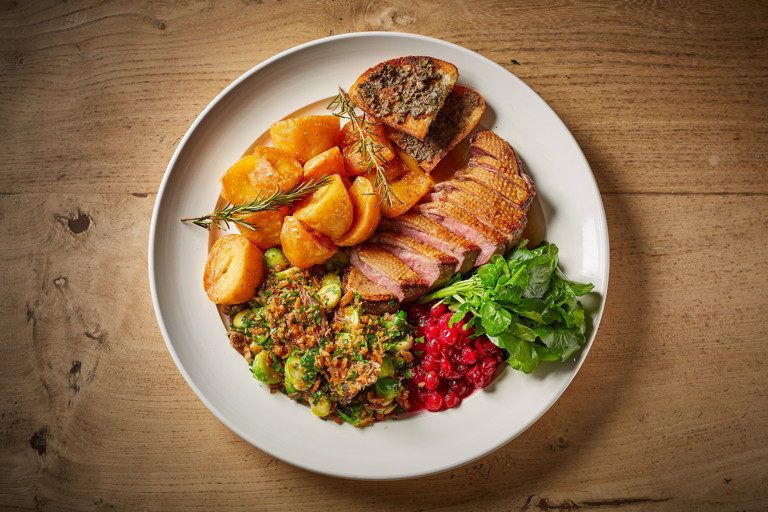Charlie Hibbert’s Christmas goose dinner
- medium
- 4-6
- 2 hours 10 minutes
Looking for the ultimate Christmas dinner recipe? Ditch the turkey and go for goose instead – you can use every piece of the bird to create the best-ever Christmas lunch by incorporating the legs into the sprouts, the fat into the roast potatoes and the carcass into a knockout gravy, leaving the easily carved roast breasts as the stunning centrepiece. This recipe might look long, but it doesn’t take much more effort than a bog-standard dinner. Charlie has also included step-by-step instructions for breaking down a whole goose into its component parts – a very useful skill to add to your repertoire. Enjoy!
If you just want to cook one aspect of this dinner – for example the potatoes or cranberry sauce – you can find the individual recipes here:
Goose fat roast potatoes ~ Sprouts with confit goose, chestnuts and pancetta ~ Cranberry sauce ~ Goose fegato crostini ~ Goose stock
Ingredients
Metric
Imperial
- 1 goose, free-range and weighing approx. 5kg
To confit the legs
- 50g of sea salt flakes
- 4 garlic cloves, peeled and crushed
- 1 bunch of thyme
Sauce
- 1 knob of unsalted butter, large
- 1 onion, peeled and roughly chopped
- 3 carrots, roughly chopped
- 3 sticks of celery, roughly chopped
- 1 head of garlic, halved horizontally
- 10 black peppercorns
- 3 bay leaves
- 1 bunch of parsley stalks
- 1 bunch of thyme, small
- 2l chicken stock
Fegato crostini (optional – requires the goose to come with its liver and heart)
- 135g of unsalted butter, plus extra for spreading
- 2 tbsp of vin santo, sweet sherry, Madeira or vermouth
- 2 tbsp of brandy
- 3 anchovy fillets
- 1 tbsp of capers
- 3 sage leaves
- sea salt flakes
- freshly ground black pepper
- 4 slices of sourdough
- cornichons, to serve (optional)
Sprouts
- 400g of Brussels sprouts, trimmed and halved
- 150g of vacuum packed cooked chestnuts, roughly chopped
- 100g of pancetta, diced
- 1 lemon, juiced
- 1 handful of parsley, chopped
- sea salt flakes
- freshly ground black pepper
Roast potatoes
- 6 large potatoes, a variety such as King Edward or Maris Piper
- 3 sprigs of rosemary, leaves picked and chopped
- 2 garlic cloves, peeled and grated
- 1 dash of olive oil
Cranberry sauce
- 1 large orange, zested and juiced
- 300g of cranberries, fresh or frozen
- 2 tbsp of redcurrant jelly, heaped
- 1 tbsp of red wine vinegar
To finish
- 1 tbsp of rapeseed oil
- 1 knob of unsalted butter
- 1 dash of olive oil
- 1 dash of red wine vinegar
- sea salt flakes
- freshly ground black pepper
- 1 bunch of watercress, to serve (optional)
Method
- 1 goose, free-range and weighing approx. 5kg
- 50g of sea salt flakes
- 4 garlic cloves, peeled and crushed
- 1 bunch of thyme
- 1 knob of unsalted butter, large
- 1 onion, peeled and roughly chopped
- 3 carrots, roughly chopped
- 3 sticks of celery, roughly chopped
- 1 head of garlic, halved horizontally
- 10 black peppercorns
- 3 bay leaves
- 1 bunch of parsley stalks
- 1 bunch of thyme, small
- 2l chicken stock
- 35g of unsalted butter, plus extra for spreading
- 2 tbsp of vin santo, sweet sherry, Madeira or vermouth
- 2 tbsp of brandy
- 3 anchovy fillets
- 1 tbsp of capers
- 3 sage leaves
- sea salt flakes
- freshly ground black pepper
- 100g of unsalted butter, plus extra for spreading
- 100g of pancetta, diced
- 400g of Brussels sprouts, trimmed and halved
- 6 large potatoes, a variety such as King Edward or Maris Piper
- 1 large orange, zested and juiced
- 300g of cranberries, fresh or frozen
- 2 tbsp of redcurrant jelly, heaped
- 1 tbsp of red wine vinegar
- 3 sprigs of rosemary, leaves picked and chopped
- 2 garlic cloves, peeled and grated
- 1 dash of olive oil
- 1 tbsp of rapeseed oil
- 1 dash of olive oil
- 1 dash of red wine vinegar
- 1 knob of unsalted butter
- 150g of vacuum packed cooked chestnuts, roughly chopped
- 1 lemon, juiced
- 1 handful of parsley, chopped
- sea salt flakes
- freshly ground black pepper
- 4 slices of sourdough
- cornichons, to serve (optional)
- 1 bunch of watercress, to serve (optional)
Get in touch
Please sign in or register to send a comment to Great British Chefs.


